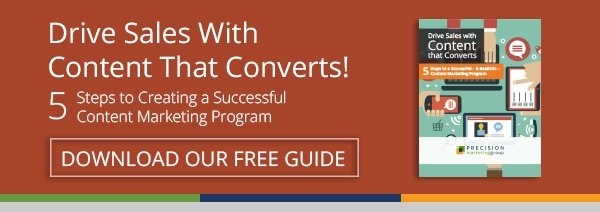It’s surprising how many companies don’t have a good handle on their leads. Their Marketing & Sales teams know they need or want more, but they don’t always know the number of leads they need in order to meet customer or revenue goals. They also might not have precise definitions of lead lifecycle stages in place or be sticking to a consistent plan to work incoming qualified leads.
If generating MORE leads is a high priority for your business, read our article How to Get More Leads: A 3-Step Process for helpful tips.
However, poor lead management is a problem that goes well beyond a lack of volume. First of all, there is so much insight to be gained from understanding the leads you do have. Moreover, the proper funneling of leads into the right nurturing "buckets" is also super important. While not every new contact your marketing generates will be qualified for a conversation with Sales, many leads who haven't yet raised their hands are, in fact, business gold and should be handled as such. And closing the loop on their respective buyer's journeys is critical for evaluating what about your marketing is working (and what isn't)—as well as for ROI to be accurately measured.
When we break this down further, there are three marketing activities that contribute to effective lead management, and more specifically, lead integrity. Here's the scoop...
1. Accurate Attribution
Identifying and learning from our leads is crucial to inform the decisions we make about our marketing strategies. Attribution is an important part of this process. Lead attribution describes the process of determining the path any given website visitor took—and the touch points they experienced on that path—while on their way to converting into a lead (and perhaps, ultimately a customer).
There are many ways to use attribution for analysis and ultimately guide strategy. A couple of examples include:
- Examining the buyer's journey of your best customers. What sources led them to you? What marketing assets did they consume? How many? And how can you repeat the process? While every journey will be different, you can build an ideal lead nurturing process to emulate as new good-fit leads convert on your website.
- Analyzing the attribution of bad-fit leads. Most marketers don’t focus on these leads enough, but identifying what sources are producing leads of poor quality—and figuring out how to not waste your team's valuable time—can be just as important as identifying top sources of your best leads!
Marketing Success Example: A manufacturing technology company has a very high growth goal for the coming year. They need to sharpen their pencil in every area of marketing to achieve this goal. They decide to analyze both the traffic source attribution and content attribution of their best leads and customers and then alter their funnels to focus on these top sources. Fortunately, they've chosen to use HubSpot for marketing and sales, and all of this data is at their fingertips.
2. Advanced Lead Nurturing
The modern prospect expects a customized buying experience. No one-size-fits-all messaging is going to pique their interest. And in the B2B world, they want to see as many proof points as possible that demonstrate your company can address their specific needs and solve their specific problems. Basic lead nurturing—which might include a few somewhat targeted emails that deliver a similar message to all leads—does not really deliver the goods.
That's why personalization and database segmentation is so critical. There are many email customization options available to marketers if the right data is captured from website forms and analytics—and correctly stored in a CRM system. Just to name a couple of ways to enhance your lead nurturing campaigns, try incorporating lifecycle stage, persona, and behavioral data into your copywriting and messaging. Even when it comes to marketing automation, you will generate a lot more engagement with your emails and content by whittling down your audience and doing your best to get as specific as possible.
Marketing Success Example: A SaaS company wants to focus on its key personas. They already have their segmentation and multiple lead nurturing campaigns in place. Thus, it’s relatively easy for them to create custom messaging within their already existing nurture tracks to speak to these specific leads. One workflow saw a 38% increase in click-through rates!
3. Lead Scoring
The primary goal of lead scoring is to ensure sales teams focus their attention on the best leads. It sounds simple, but it isn’t always so. If lead integrity is questionable, it’s not possible to score leads accurately. One common culprit of incomplete or false lead information is when the CRM system isn’t integrated correctly with marketing and data isn't being passed back-and-forth. (Ideally, Marketing and Sales will use the same system, but we know many businesses still use one platform for marketing and another platform for sales).
But more often than not, the biggest reason why lead integrity isn't accurate is because Sales and Marketing are not regularly meeting and sharing insights—and have not come up with joint definitions of "qualified leads" or what attributes (behavioral data, firmographics, etc.) can help identify them. Without this information, an established lead scoring system isn't really going to work well, and Sales will continue to be disappointed with what Marketing is delivering. Managing and refining your organization's lead scoring system can make a big difference in how successful your sales efforts are (and how well spent their time is)!
Marketing Success Example: A medical records company wants to score their leads for a particular campaign. The criteria will vary from the traditional scoring they use based on this market segment. Fortunately, they recently did an audit of their CRM integration with their marketing automation platform, and all the lead data they need is being passed through correctly. And Sales has verified its accuracy. They can create this new lead scoring system with the confidence of having the correct information!
Note: I was recently reviewing lead scoring best practices and came across this lead management eBook by HubSpot. This resource offers a comprehensive overview of both the strategy and technology involved with all aspects of leads management. I was compelled to download it because so much of what we do as marketers comes down to lead management. If you need a resource on how to manage and nurture your leads, this is a perfect read!
As you can see, lead management affects many aspects of marketing and ultimately, sales. Are you confident that your company is tracking and trafficking leads in the most efficient and precise manner? If yes, good for you! You are ready to engage in activities that can have a positive impact on your business goals. If not, take the time NOW to explore how to improve your process. You’ll be glad you did!




